
Free Your Organization from "Stalled" Thinking | Reading Room BY DONALD MITCHELL, CAROL COLES AND ROBERT METZ |
Introduction There's gold in them thar hills. Have you ever fallen behind the competition? Wondered why great opportunities for your organization remain untapped? Wanted to add new strengths to your organization, but could not? Grown frustrated by persistent problems that have been around for decades in your company? If so, this is the book for you. It focuses on the bad habits, what we call "stalls," that cause these problems and tells how to overcome them. Whether you are a leader, problem solver, trainer, or educator, you will find answers in The 2,000 Percent Solution. What Is Stallbusting? Weigh Your Choices Consciously Where It Counts Learning not to give in to stalls creates the opposite result. The potential for progress, personal and professional, can be astonishing when we apply better habits of thinking. With conscious thought to challenge our habits, we can eliminate stalled thinking and move on to opportunities that have major payoffs, opportunities that our habits have been steering us away from. What Is a 2,000 Percent Solution? Shoot for the Moon When It Counts We often do a task the way we always have even though a vastly better alternative is available to us. And often that better way is a 2,000 percent solution. For example, a semiconductor manufacturer spends seven months designing its own chips. But a supplier can design the chips more than twenty times faster, in less than ten days. This is an enormous benefit to the manufacturer because having new products available to its customers sooner is worth millions in extra sales and profits. Using the outside supplier here is a 2,000 percent solution, which simply means creating twenty times more benefit or doing something twenty times faster than the manufacturer's normal, 100 percent solution. In this example, the outsourcing alternative is both twenty times (2,000 percent) more beneficial and faster for the semiconductor manufacturer. What Is the Key to Exponential Success? Focus Like a Laser The basic problem that every organization faces is how to decide what to pay attention to and what to spurn. As a culture, we suffer from information overload. At any particular moment, individuals and organizations automatically ignore 99 percent of the data that are being sensed. It is a curious fact that the information we need is always out there somewhere, but mind-set stalls cause us to ignore or dismiss the pertinent information needed for the 2,000 percent solution. By reading The 2,000 Percent Solution, you will learn the stallbuster's approach to uncovering the major opportunities being delayed unnecessarily by stalled thinking, and thus discover the key to exponential success. Chapters 1 through 8 include organizational and personal examples and sample solutions that you will be able to use to explain to others in your organization what its problems are, what stalls are, and how you can overcome them. Each chapter can be read as a stand-alone essay and also includes stallbusters, or action guides, at the end to help you apply the lessons to your organization. First review the chapters applicable to your own important issues. Then visit the other chapters for additional ingrained stalls that you may not yet perceive. Hre are a couple of examples: Chapter 3: You've Got to Be Kidding! The Disbelief Stall "Wonderful though your gadget may be, Mr. Fahrenheit, you'll have to admit that people know they need coats in the winter and that they don't need them in the springtime!" Organizations usually fail to perceive the potential of the most important new information, technology, and ways of operating. This occurs because the new piece of information or resource unexpectedly makes untrue what has been true in the past. This chapter focuses on your opportunity to seize advantages by appreciating the implications of critical new areas you know about today but are incorrectly discounting as unimportant to your future. Disbelief: Limited Imagination and Blind Spots The disbelief stall is based on a valid experience, lack of relevant experience, or a previously established reality that no longer pertains. In the horse and buggy age, the thought of going sixty miles an hour for extended periods of time was beyond belief. Yet soon after the automobile was introduced at the turn of the century, such speeds were attained in races. There is a strong tendency in the business world to react with disbelief to any important change. The most revolutionary changes meet with the most skepticism and are less likely to succeed initially, in part because capital sources are conservative. The bigger the idea, the more likely it will boggle the minds of those who are needed to bring the idea to fruition. Consider this: One hundred years ago, Alexander Graham Bell supposedly offered his ailing telephone business to the then king of communications, Western Union, for $100,000. Western Union's boss scoffed at the idea, disparaging Bell with the words, "What use could our company make of an electrical toy?" The man's reaction is not surprising. In the last century, technology grew slowly. And even today, as we have seen, it is not easy to leap into the future with a novel idea that challenges present methods. Thomas Kuhn, a Harvard-trained philosophic scientist, uses the term "paradigm shift" to tell what must happen in a person's mind-set before a novel development can be understood. We are forced to fundamentally challenge the status quo before we can develop new ways of looking at things. New Paradigms for Old Thomas Kuhn's book, The Structure of Scientific Revolutions (University of Chicago Press 1962), sets forth his paradigm concept in detail. He states that those who break through to invent a new paradigm are almost always either very young or very new to the field whose paradigm they change. He wrote that the more flexible younger innovators, being little committed to prior practice and to the traditional rules of normal science, are particularly likely to see that those rules no longer define a playable game and to conceive of another set that can replace them. As a real-life example, consider the experience of Solar Box Cookers International. In the poor areas of Africa and India where 100 degrees Fahrenheit is an everyday condition, cardboard boxes lined with 10 cents worth of foil are offered as solar ovens. These ovens may well free millions of Women and children from the all-consuming daily task of gathering twigs or cow dung to fuel the hearth for supper. Solar Box Cookers International found that it was the children, not the adults, who were eager to use it. Even after the children cooked dinner with the solar oven, it was still quite difficult to overcome the disbelief stall in their own parents. Kuhn's disciple, Joel Barker, in Paradigms: The Business of Discovering the Future (HarperBusiness 1993), says a paradigm is a theory or dogma that establishes boundaries and regulations. Paradigms filter data and can prevent discovery of new developments from outside the paradigm. Barker asks us to assume that the impossible in our business could, in fact, be done. He asks, "Would that change fundamentally what you do?" This is crucial to understanding his "going back to zero" rule: When a paradigm shifts, everyone goes back to zero; that is, past success guarantees nothing. The Swiss did, in fact, invent the quartz movement watch, but the hidebound among them snubbed it. They did not go back to zero in their thinking. Past success had blinded them to the new future of watch-making. Barker's book and video set forth examples of paradigm shift: the airplane, the telephone, the radio, the photocopier. Their developers were open to new concepts—to new ways of looking at the world. Those who say it cannot be done should get out of the way of those who are doing it, Barker concludes. Why Would Anyone Need a Phone? Bell wasn't really thinking big initially; he wasn't moving to a totally new paradigm. He just thought he had a way to improve on the town crier. He expected to use the phone as a news medium. With each new technical advance, would-be users and, yes, even the inventor (like Bell himself) may be stymied by clinging to the old ways. They figure that the new knowledge will be employed in the same way the old knowledge was. For their part, householders wondered, "Why get a telephone when I can step outside and talk to my neighbor over the back fence?" In Bell's time, people rarely left their immediate neighborhoods. They could walk that far. Not having identified a need, they asked, "Why should we have a telephone." Later, people were to react similarly to cell phones, asking, "Who needs it?" But when people get cell phones, they begin by calling friends to enthuse. Then they make far more calls than they expected as the usefulness of the device quickly becomes obvious. Husbands often buy cell phones for their wives who are at risk if the car suddenly breaks down at night. Forget minimum rates. New cell phone customers often use the devices so much they rarely qualify for minimum-use fees. Who would have imagined in those early days of Bell's "electrical toy" that someone in Europe would someday pick up a phone not radically different from the one Bell invented to call a bank in, say, Singapore? Or that a homesick immigrant would pick up a Brooklyn telephone to call a relative in Crete? Why Would Anyone Need a Computer? The usefulness of electronic computers, created during World War II, was suspect even to their most avid supporter. Thomas J. Watson, Sr., who was to build IBM upon mainframe computers, was quoted in 1943 as saying there was probably a world market for only five of the monster machines. The early computers were certainly formidable. These mainframes took up a major portion of an entire city block. There were no desktop personal computers or other small units back then. Processing with these lumbering giants was molasses slow relative to the lightning speed of our desktop PCs today. The early software engineers had to write programs that weighed every possible contingency because it took so long to run a program that users could not afford mistakes. It is no wonder no one believed computers would ever be widely marketable. Under the first computer science paradigm, it was believed all computer operators would have to be scientists, each one writing his or her own programs. But that notion dissipated as manufacturers developed ever smaller and more powerful chips to replace vacuum tubes and ferrite core memories. Profiles in Disbelief The Watch That Became a Dog. Skepticism follows naturally if an innovation is revolutionary. Consider the reaction that a tuning fork, offered as a timing device, got during the heyday of mechanical wristwatches. Those watches had a mainspring and a stem to wind them up. A series of tiny, precision gears were linked to hands on the face that registered the time. These watches were universal a generation ago. Even though jewels were employed as a means of reducing friction, watches were, by and large, inaccurate by today's standards. Most of the premium watches with so-called Swiss movements (many of the top watches were made in Switzerland) lost or gained a minute or more a day. Predictably, at the annual watch industry exposition some thirty years ago, all the watchmakers' booths but one featured timepieces with Swiss movement. The one dissenter was dismissed as a maverick though he was about to strip the gears. His neglected display is said to have featured a remarkable timepiece equipped with a tuning fork and a tiny battery. The battery energized the fork, the tone of which was wedded to a timing mechanism that marked passing seconds, minutes, and hours. This tuning-fork watch was more accurate than most ticktock watches, and it redefined the playing field. Back at that exposition thirty years ago, the other participants could not imagine that these highly innovative watches would have a shattering impact on their trade. But the quartz crystal watches that rule today's market are the tuning-fork watch's direct descendants. Swiss movements have 10 percent of the wristwatch market, which is down from their 80 percent market share in 1969. In hindsight, the threat to watches with Swiss movements is obvious. It isn't over yet. Time is such a key element in our lives that inventors keep finding better ways to measure it. Some of the old ways were novel, if somewhat rough-hewn. Early in this century when the horse and buggy were still in vogue, workers who could not afford clocks would tie a shoe to a nail, pushing the nail into a candle well below the wick. When the candle burned down far enough, the nail slipped through the hot wax, and the shoe would hit the floor with a "clunk." The sleeper awoke in time to go to work. Primitive? Certainly. But for its time, the device was an effective means of alerting people to the hour that mattered most. Today, we require mind-boggling accuracy in our timepieces. For example, without precise synchronization, achieved through atomic measures of radioactivity, communication on the Internet would quickly collapse. I'm Not Listening After the trade show ended, the master of the tuning-fork watch accomplished something few others with new ideas have: He was soon able to find an audience and take over the market. By contrast, a few years ago, a small American company, New Age Industries, created a revolutionary new way to transfer kinetic power, a potential replacement for gears found in transmissions and nearly every other mechanical device. This demonstrably superior system was based on computer-derived gearing designs precise enough to offer up to 30 percent energy savings in many applications. The company hoped to sweep the market like a second hand sweeps the face of a Swiss movement watch. All the company needed was a production partner. It conducted market research to see which industries and markets had a history of accepting and introducing new concepts successfully. The research examined dozens of product categories and management processes. In every case, someplace other than North America was the most promising area in which to market a revolutionary business technology. In fact, the best leads came from Japan and other advanced Asian nations. But the super-gear company had no experience in the Far East. Sadly, the company was unable to complete the sale. It turned out that most gear makers and users were content with the status quo. They were not convinced that the proposed capital investment would pay off. Ignore It and It Will Go Away Sometimes the disbelief stall is colored by feelings about short-term self-interest. Suppose someone walks into your office to offer you a variation on your primary product that, due to new efficiencies of production, can sell for half the price your product now commands. You are likely to be more shocked than pleased, unless, of course, you anticipate that the dollar value of the market will grow much larger. Failing that, the adoption of the outsider's product will probably cause your profits to drop. You may bear the extra burden of replacing specialized equipment and people. Who needs this? Your mind may play tricks on you. For example, you decide the new product will, in fact, cost more to produce. The disbelief stall is taking hold. You drag your feet, hoping you will be promoted and someone else will have to decide. This stall is very destructive. The business world is dynamic: He who hesitates is lost. Tunnel Vision Darkens the Big Picture To a surprising degree, managers, both those who know computers and those who do not, tend to see them in terms of their existing, standard applications. Most managers can easily understand the computer as an engine of personal productivity or as a tracker of production. They could, for example, understand computers used to prepare accounting. But many do not realize they can embed software on a chip in their finished product to help improve service. Let us assume a company buys a piece of capital equipment for the factory. If that machinery has embedded software, the customer can call the factory, connect to the equipment chip by modem, and learn what repairs it needs. Another application of this idea is the V-4 truck engine, the Rodi HTI-450, developed by a former Boeing engineer. It has such a chip along with a cell phone and modem for remote diagnostics. Similarly, Cadillac has a code system in a dashboard button that lets mechanics check the car's diagnostics and learn what needs fixing. Stall Erasers Creative People You should seek out the help of people who enjoy creating new solutions. These types of people are eager for new challenges. You may also find these helpful hands among suppliers, new employees, customers, and outside experts, including academics. Their imagination can be supplemented with your own good leadership. In the same way that no two people have identical kinds of curiosity, organizations have personalities that favor or disfavor various ways of looking for new solutions. Likewise, you can easily imagine that Intel, Microsoft, IBM, General Electric, and Disney would take quite different approaches to dealing with the same issue. You should examine your organization's personality and consider how it can be expanded in useful ways, perhaps by adding new partners and new competencies. Positive Thinking Starts the Exponential Progress Engine. To overcome the disbelief stall, you need to have a positive outlook. You have to believe wonderful things are just around the corner, if only you look for them. You have heard the old debate about the glass being half empty or half full. People who see a half-empty glass tend to see potential problems wherever they look, which also encourages them to focus on avoiding loss. It makes more sense to imagine potential opportunities. Ask yourself a positive question about any situation that occurs. Imagine you were being asked to use a computer for the first time. Instead of fighting this new responsibility, ask yourself how this would make it easier for you to get home on time. It is also good to adopt other new beliefs about what is going on around you, beliefs that help you grow and exploit more and better opportunities, such as a belief that 2,000 percent solutions abound for those who seek them. View roadblocks as in disguise. For example, if you can find a way to solve an especially difficult problem, realize that you are solving it for others in your organization. This viewpoint can add to your ability to help your organization as well as your customers: When you solve a recurring problem, you save time again and again. It is also helpful to believe that all things that happen have a purpose: to help you improve. Adopt the idea that large changes are fundamentally good and possible. If something is unacceptable, remind yourself that there is probably at least one way you can change it. Once you believe you can make a change, work on making it a change for the better. If something happens to you that has not happened to you before, ask yourself, "What am I supposed to learn from this?" This upbeat way of looking at things makes life much more interesting, especially when this point of view is applied to what first appears to be temporary adversity. Using positive thinking about how a new technology can solve day-to-day problems is hard work, but this approach can be immensely rewarding. A useful thing for you to do is to make a list of things that your organization does now that make little sense, but that need a new solution before they can be improved. Then you can match new ideas and technologies as they are developed to solve these problems. Back-to-Zero Goal Setting Even those with progressive mind-sets can be captured by disbelief and lose the chance to grow exponentially. The feeling is widespread that 15 percent growth is high. But an organization that sets an ambitious goal to grow 15 percent per year may be ruling out more attractive choices. Curiously enough, there are situations in which growth targeted at 25 percent per year is in fact easier to achieve than 15 percent growth. With that surpassing goal of 25 percent growth, everyone in the organization realizes new thinking is required. The goal can also help attract imaginative people to the organization who like to think differently. Stallbusters This section focuses on your organization's blind spots, the places where you do not see what is happening or is about to happen. You will learn how to eliminate or compensate for these blind spots so that you will not lose important opportunities as a result. Locate Blind Spots At least some of the things you are not thinking about or not taking seriously are missed opportunities. A good rule of thumb is to be aware that the more often you have heard about something, the more significant it is likely to be. Ignoring new information one time will usually be okay (unless someone is warning you about a car that is about to run over you), but to ignore it more than once is risking being stalled by a blind spot. To help identify your company's blind spots, ask yourself the following questions in the context of what the feasible reactions might be: What things are your competitors doing that you have decided to ignore? Maytag recently scored a remarkable coup in the washing machine business by producing a premium-quality, premium-price front-loading washing machine. Front-loading was a technical direction that had failed repeatedly in the past. Some of the problems included leaks around the door, insufficient cleaning, and wear on the washer parts. Maytag decided to revisit this form of washing machine because of its potential to reduce wear on the clothes being washed and lessen the amount of water needed. It was well known that Maytag was working on this approach, but competitors chose not to respond immediately because they assumed that the product would fail. Instead, the product enjoyed a wonderful reception, and Maytag's competitors are now years behind in responding. If you were one of Maytag's competitors, then you would have described Maytag's front-loading washing machine while the new Maytag product was under development. What things are the communities you do business in talking about that you have ignored so far? Sticking with the washing machine example, more and more communities are having problems with treating wastewater. Insufficiently treated, wastewater from washing machines helps generate those disgusting bubbles that cover rivers, streams, and lakes in many parts of the United States. If you do not have a front-loading washing machine under development, then you may not be addressing the question of how to produce washing machines that create less wastewater. Notice, too, that creating a design that requires less detergent and other cleansing and whitening agents (like bleach-based products) would be very helpful for wastewater disposal. Further, you could take another approach to solving the wastewater problem and create a machine that cleans and recycles its own water. If this approach were inexpensive enough, it would be a customer benefit as well because the householder would not have to buy so much water to wash and rinse clothes. If it's not yet economically feasible, perhaps you could find a way that the water could be treated well enough by your equipment so that the householder could reuse it to water the garden and save money that way. But perhaps neither of these options is yet feasible, so you could consider designing a machine that could use laundry products that are much cheaper, faster, and easier to remove from wastewater. In fact, if you did this well enough, you might be able to sell custom laundry products for your equipment and have an additional source of profits. If it were more economical for someone else to manufacture and distribute these products for you, you could outsource those activities. Better yet, how about a waterless washer? Sounds crazy, but such a technology was announced in late 1998. What negative feedback do you get from employees that you have been receiving for at least two years? In the washing machine business, there are two concepts about what the future holds. Maytag recently sold its foreign operations based on a reported belief that the company does not have to be a worldwide competitor in order to succeed. Maytag's competitors are often pursuing just the opposite strategy, expanding throughout the globe with local manufacturing and products. Recently, some of this activity has created machine and parts commonality in some regions around the world as a way to reduce costs. If you were one of Maytag's competitors, you would probably be hearing from employees that they are very much in fear for their jobs. Globalization has often meant the end of high-paying, low-skill union jobs in the United States. This circumstance can distract employees from working on ways to improve operations and create a hostile labor environment, including difficult strikes. General Motors experienced just this circumstance with regard to outsourcing the manufacture of auto parts in 1998. We can safely assume that there will always be a need for washing machines in the United States. Will there always be a need to manufacture those washing machines in the United States? Many companies have found that the United States is a wonderful place to manufacture products that benefit from a highly educated, flexible, and well-trained labor force. If you retrained your labor force to be more like this, how could that help your manufacturing capability? One possibility is that you could switch to a different approach to manufacturing so that the washing machines are assembled and shipped within minutes of receiving the order. This could provide lots of additional sales by providing rapid response to changes in consumer buying patterns. Your customers (wholesalers and retailers) would be more profitable because they could carry less inventory, and you might be able to charge a little higher price for this service. Plus, your own inventories would be at least a little smaller, saving investment capital otherwise tied up in working capital. What are the perceptions held about your company and your industry that you are not addressing? The washing machine business is hardly a high flyer. Those who follow these companies usually assume that nothing will happen. That is a very interesting environment to do business in. One reason that Maytag was able to surprise everyone with its new washing machine was that the new CEO was felt by many to be someone who would launch few changes, both because he was a carefully groomed internal candidate with a financial background and because there appeared to be few changes that a new CEO could make. Observers were then quite surprised when he quickly sold the European washing machine operations at a loss and successfully launched the new front-loading product line. For Maytag, it was a good time to question all of its assumptions because observers and competitors alike were probably asleep, so there was room to move without inviting an immediate response. Evaluate the Implications of the Blind Spots Once you have compiled your list of blind spots, or even a partial one, ask yourself the following questions to help you evaluate their implications: Which blind spots are in areas where your organization's actions can improve or worsen your situation? At least some element of every issue that was raised in the Maytag example could be addressed fully or in part by developing new ways of designing and manufacturing washing machines. To the extent that a Maytag competitor did not address other customer, user, and community issues (unknown to us, but likely known to the Maytag CEO), these other issues too may point toward opportunities for new products and other manufacturing processes. Let us assume that this observation in the prior paragraph about the development potential for new products and manufacturing is correct for now. How could new product development help? Obviously, to the extent that the new product development efforts focused on eliminating these blind spots by serving the unmet customer, user, and community needs described in the Maytag example, the company would be better off, all other things being equal. How could this get offtrack? One possibility is that the new design efforts produced products that worked well initially, but that failed in the long run because of design errors (the parts wear out prematurely, the seals leak water, or the clothes are damaged rather than just being cleaned). Disgruntled customers would be swearing never to buy your products again, your warranty costs to repair or replace the machines would be enormous, and the negative publicity would scare off investors and potential customers. Another problem that could occur with new products is that it would take a long time to solve the problems identified in these blind spots discussed earlier in this paragraph. If such delays occurred and too many resources went into new designs, the company might find itself with too few new models, and ones that did not offer any particular advantages other than new colors and shapes. When would you need to act to get most of the benefit or avoid most of the harm? The answer to this question is always a somewhat relative one. As long as you arrive at the solution before anyone else, you have the opportunity to seize much of the advantage from having the initiative. In the relatively sleepy washing machine industry, there may be little time pressure. However, Maytag's very success with its new model could change that. Many companies now realize that advances in computer-aided design of machinery allow problems to be solved quickly that earlier could not have been solved at all. Seeing someone accomplish that positive result in a previously difficult area such as front-loading washing machines may encourage aggressive companies like Whirlpool and General Electric to accelerate their new product development into previously unproductive areas. If each company immediately expands its new product focus, the fallout of the Maytag success may be to greatly reduce the amount of time available to obtain competitive advantages, making blind spots even more dangerous to your success as a Maytag competitor. Maytag's decision to exit the global washing machine business raises especially interesting questions about timing. If Maytag is wrong in that decision, the company may have little time to recover from its decision to pull back because its competitors are rapidly expanding in this direction and seeking worldwide cost-reduction benefits from having globalized their businesses. With few potential partners left, Maytag could end up with only the option to sell itself to a competitor after these cost efficiencies are developed by its competitors. What is the minimum evidence that would tell you that you should act immediately? This is a tricky question for the new products design area. If blind spots cause you to wait too long, you can fall behind in introducing the new products. Some clues to timing include large increases in design activities at competitors; expanded scope of new design solutions being sought (suppliers may tip you off to this); more powerful resources available for solving the problems (this could include ventures with partners who have related technologies, adding much more powerful computer and software problem-solving capabilities, and making acquisitions of companies with related expertise such as one in the water treatment area); and actual word of trials being conducted successfully in the laboratory or the field. Stories about speeches made by company executives or disclosed to securities analysts could also tip you off to a new direction that requires an immediate response by your organization. Chapter 6: Words Fail Me. The Communications Stall When someone in your organization correctly perceives a high-value opportunity, to capture the benefit that knowledge must be effectively communicated to those who can act. So that you can create truly effective and rapid sharing of critical information and knowledge, this chapter shows you how to overcome the harmful assumption that information or knowledge is perfectly received every time someone in your organization tries to share it. Film director Cecil B. DeMille spared no expense to part the Red Sea for his epic The Ten Commandments. Actors, engineers, horses, and assorted other animals were everywhere. The dust, heat, and noise were ferocious. Finally, everyone was ready to go and DeMille called out, "Roll the cameras." After he finished shooting the scene, DeMille called to a cameraman on a high cliff to check on how that part of the shooting had gone. The cameraman reportedly yelled back, "Ready when you are, C.B.!" What was the boggle here? What was DeMille's stall? He thought that everyone heard and understood his message whenever he spoke. But in this case, he never checked to see if the camera on the cliff was rolling before starting the scene. The solution: Check first to see if your message is received and understood before going into action. Ask people what they have heard and what they plan to do, and then keep repeating the same message in different ways to reinforce your point. This story delivers an important lesson: In business, we have to be sure that we all get the message—and at the right time—in order to get the results we want. Too many times messages are either not sent, not received, incorrectly understood, or not acted on in time—as happened with DeMille and his cameraman. The da Vinci Communications Stall That Delayed History for Three Centuries Imagine that you are Leonardo da Vinci's employer back in the fifteenth or sixteenth century. Da Vinci is one of the greatest geniuses of all time, but you have hired him to design your city's fortifications. In his spare time, he is busy designing other things that he does not share with anyone. Da Vinci put drawings of many inventions in his trunk, then turned his attention to the more immediately profitable projects preferred by his employers. In fact, Leonardo was to spend most of his life manually recording his secrets in a novel manner that required a mirror to render the text intelligible. Buried in da Vinci's notes was a remarkably viable design for a bicycle. We did not get actual bicycles on the roads and paths for another three centuries, not until 1839, when a blacksmith introduced pedaled bicycles in Britain. If only the design of Leonardo's bicycle had been communicated, not stalled, recorded history might have had a faster ride into the future. Increased travel might well have vastly improved commerce and communication. People didn't travel much then. Large numbers no doubt lived their lives without ever seeing the next village. Back then, the Catholic Church was the font of literacy. Catholic monks laboriously recorded Bible text by hand. The priests passed Scripture to the illiterate by word of mouth. Had they bikes, the monks might have ridden over the footpaths between the parishes with some frequency. Monks had families and friends among the laity. It is not farfetched to think they might have begun carrying notes between friends and businesses. The demand for literacy could have found its way sooner into the community at large. As growing numbers of people learned to read and write, they would look for easier ways to put ideas in print. The printing press might have become popular sooner to meet the demand. (Also buried in his trunk was a printing press modeled after Gutenberg's that could be operated by one man. Gutenberg's press required two printers to roll the presses.) Progress on the march. As a post office developed, commerce might have bloomed earlier. The powers-that-were might have used cheap labor to build better roads. Da Vinci fell prey to the communications stall. He normally decided to communicate little about his ideas, and only selectively at that. He may have assumed his employers would only be interested in one or two of his capabilities and stopped communicating about the rest, or he may have feared his ideas would displease the church and lead to excommunication. His employers, in turn, were held back by the misconception stall that Leonardo could only help them in the areas they had already talked about. They never found out about what was in those notebooks. More typically, communications stalls occur as we try to express ourselves but fail to do so. We hear the words but don't get the message; or we get a message, but it's not the message the sender meant to convey. Remember the childhood game of telephone or whisper down the lane? Kids sit in a circle or a row, and one child whispers a story in the ear of the next one. This is repeated until the story makes the full circuit. The last child tells the story out loud to disbelieving ears because the final version is completely different from the original tale. "The red rooster crowed" might become "The red head drove a wrecked roadster." Similar mutations occur with facts, expectations, and directives in the business world. As company policy is set forth and circulated throughout the company, by whatever method, the end result is often far from the original intent. This muddying of the message is somewhat understandable when a new policy is passed on by word of mouth, less so when the new program is committed to writing. Regardless, due to the limits of training and the ability to express thoughts clearly, many a written memo (or e-mail) is nearly as likely to be misinterpreted as a verbal policy directive. Just the Facts, Ma'am Seeing Is Believing In the 1980s, there was a U.S. manufacturer that was widely considered to be a top producer of roofing materials. It was prohibitively costly to ship these heavy commodity products very far, so foreign manufacturers were willing to share information with those outside their home market. The division president often visited noncompeting plants in distant locales to get ideas—to see if others in the trade knew something he did not know about manufacturing. He knew that Japanese companies were good manufacturers, so he flew to the Orient to see how they produced materials similar to his. As it turned out, the Japanese were using the very same equipment he was, but he discovered something amazing. He used thirty people to run each line. His Japanese counterpart used only eight. He returned home elated. He was dazzled by the potential impact on profits and on the company's growth prospects if eight people could do as much as thirty. He was totally open about his plans, communicating them fully to his aides. But when he told his manufacturing chief the story, the man said, "Baloney!" So the division president went to Japan with the doubter and showed him the lightly manned production lines. The manufacturing chief became equally excited: "You are right!" he said. "You can run the line with just eight people." The two came back and told the company's plant managers the story. They said, "No, no, you don't understand what we are doing here. What you say is impossible." Back to Japan again. This time it was the plant managers who were floored. They said, "You know, you are right! But the guys in the plant won't believe it. Let's create a videotape so the shift supervisors can see that the system works." The tape was made, and the shift supervisors were corralled and shown the video. "Nonsense," they said. "It can't possibly be. Someone doctored the tape." The division president said, "We'll go to Japan one more time. But this time, I'm going to ask the Japanese to let us operate their factory for two weeks. We'll man production line jobs and see what happens." Back to Japan. The supervisors worked on the line for two weeks. Then and only then was the division president able to make the change to eight-person lines. In this case, seeing and doing was believing. No amount of talk could get the message accepted. No News Is Not Good News Some managers are ingenious at conveying a message. Others make no attempt to pass on important ideas and information. There is a difference between failing to communicate effectively and a total lack of communication. Employees do not react well when they receive a poorly conveyed message, but they become far more angry when they feel management does not care enough to even try. When people feel they are being purposely ignored, morale is severely damaged. We all tend to communicate most with the people we like. Thus, when employees perceive that their managers are making little, if any, attempt to communicate, they leap to the understandable conclusion that this is because the managers do not care about them. Other executives take the high road and wind up at a dead end. These jovial executives are so eager to be liked, they set about to build positive relationships with employees by avoiding conflict. Solving problems is unpleasant and emotionally trying. So they avoid talking about them altogether. Critical problems go unaddressed and the business suffers. In reality, employees react better to effective problem solvers than to bosses who seem to be avoiding conflicts by not addressing them. Stall Erasers Overcoming Hostility and Establishing Relationships The conductor asked, "Where's your ticket?" I said, "My face is my ticket." So he punched it. -Anonymous Sometimes hostility and competitiveness induce a communications stall. For example, when people negotiate, they tend to be wary and competitive. Professors Roger Fisher and William Ury in Getting to Yes (Houghton-Mifflin 1981) find ways to neutralize these negative influences by asking both sides to try to understand what the other person needs to accomplish. When each knows what the other wants, there is more chance of arriving at a solution satisfactory to both, the proverbial win-win solution. A classic example of competitiveness stalling a team effort occurred at a recent leadership conference. The attendees had been divided into groups and were asked to brainstorm on the same set of difficult questions. The room was full of successful executives accustomed not only to winning but to being the focus of any team effort. Soon everyone was interrupting, shouting, and saying dumb things. One team finally broke the negative barrier by deciding to set ground rules. The most important rule was a decision to "get acquainted." The group members quickly discovered each other's fields of business and specific expertise. Then they turned to the questions. Their initial disagreements dissolved as each expert was allowed to speak in turn. Their ideas and views were then posted on a blackboard. Each executive then felt that his experience was being respected and heard. The team finished quickly and successfully. When time was called, the other teams were still at loggerheads. The lesson here is that you are unlikely to find solutions among high achievers in a group unless you first establish a positive environment for communication. Establishing a relationship fosters communication even across cultural gaps. A correspondent on National Public Radio argued that the French are not impolite as so many Americans believe but instead are misunderstood. In many cases in fact, Americans come off as rude to the French. All too often, they will walk up to a French person and start speaking in English. If you approach a French person for help, start by saying, "J'ai une problme" (I have a problem). The NPR correspondent said the French love a challenge. This will manifest itself in a polite attempt to solve "une problme." Frigidity will melt as it did in his taped encounters using this approach. Stallbusters The most successful managers describe how they can never communicate enough, often enough, or in enough ways. Focus on ways to do this easily, effectively, and efficiently, and you'll soon discover 2,000 percent solutions busting out all over. Build on Success Using sources such as the results of employee surveys and individual feedback you have received, select a few examples where communications have worked much better for your organization than usual. Why do you think that these communications were more successful? One company found that it could greatly improve communications by employing a multipart communications strategy. The first part was to focus significant communications around ways that employees could get promotions, raises, and larger bonuses. Employees liked communications that helped them be more successful and were interested in what was said in such communications. The second part was to provide a videocassette recorder in each work location throughout the company so that all employees could receive information and any required training on the spot. Typically, a cassette would be reviewed just before the regular shift started. Then the employees had the chance to use the new information on that shift. The third part was to have a local manager provide immediate feedback on how each employee was doing with the new information. This meant that during the shift after the new information was received, the manager was there to answer questions, demonstrate in person the proper methods, and correct errors as they occurred during the shift. Another well-known company with a fine reputation for service quality employs a different approach to communicating with employees about what they should be doing. The company starts by selecting employees based on their interest in providing the services the company is selling. Then the company puts the employee through a rigorous training program, starting with two weeks on the company's values and culture. One-third of all new hires drop out or are fired during these two weeks because the fit between employee and company is, in fact, poor. The successful employee is then trained on the job, using a combination of very thorough manuals (often 150 pages long for jobs that competitors train their employees to do in five minutes), for at least six months before the employee is allowed to work unsupervised for even a few minutes. What do you think the average duration of employment is in this operation? You guessed it, only six months. But those who stay do a terrific job of watching out for those who will not stay so that they also do a terrific job. The cost of the extra training is more than covered by the increased sales the company enjoys at premium prices. What these two examples have in common is that a lot of communicating takes place, the communications are obviously relevant to all involved, and the information is conveyed when and where it will do the most good. How can those lessons be carried over for other communications? Consider the contrast between the examples and the way many organizations routinely communicate. A standard internal communications approach is to have the CEO make a speech, report on the speech in the employee newsletter, send out a memo, post the memo on the bulletin boards, and then drop the subject. A more advanced communicating organization might also replay a video of the CEO's speech throughout the working areas for a day or two. Obviously, not all employee communications deserve the amount of attention that the companies mentioned previously use. If the communication is valuable, it is worth communicating in the most effective way. If the communication is not very important, perhaps it should not be made. A large number of items can be covered during the type of question-and-answer sessions that many company leaders hold as they visit various sites in the company. Those questions can also be reviewed for patterns from session to session in order to see where employees want more communication. Another alternative is to use prerecorded hot lines on various subjects. Those who want to know can then update themselves conveniently. Often the same toll-free communications lines can be used with the same messages for employees, investors, and customers. If not overused, e-mail can make quite a large difference for routine information. People can indicate what they would like to be kept posted on. Discussion and working groups can be formed for those with interests in certain areas. In fact, some intranets have virtual offices with virtual water coolers where employees can share information with each other, based on mutual needs and interests. How can the same results be achieved more easily and efficiently in the future? Whatever communication method you use, be sure to measure how well it works so you can see if you need to switch to something more effective next time. A great way to do that is to spot-check what message people have received. If the method is not working as well as you would like, talk to people to find out what went wrong. Then you have a choice between reworking that type of communication to make it better and shifting to another method that works better already with less effort. Whatever your decision is, keep checking on what is working and what is not so that you can run experiments to get better results with less effort. What was missing from the effectiveness of problematic communications? So far, the discussion has been about getting or not getting the message. Another issue is how motivated employees feel to act on what has been said. Typically, even when a message is received and understood, little action follows. The natural tendency is to go back to what people have been doing unless the message is continually reinforced by a personal commitment that the employee feels. Be sure to consider two other factors that influence motivation: the strength of the emotional appeal of the message and the popularity of telling the employee exactly what you want him or her to do. Focus on Effectiveness: Results Are Where the Rubber Meets the Road Who is or was the most effective communicator you have ever heard? Many CEOs will mention either President Reagan or President Clinton. The CEOs observe that each man used simple words in simple sentences to make a few simple points. Compare this approach to the typical communications you send your employees. Many organizations find that their communications have all the clarity, appeal, and immediacy of the latest academic how-to book on some esoteric subject. Why were they effective? Effectiveness is always to be measured by the person receiving the message. You and another person may draw totally different conclusions about the effectiveness of certain communications. For example, many people who have talked with President Clinton in person report being very impressed by the way he totally focuses on the person he is talking to at that time. The listener feels compelled to pay just as much attention as the speaker is giving. Students of the subject also point out that each person has different ways he or she likes to receive information, so the best messages are those that communicate in a variety of ways. The more that each person sees, hears, touches, and feels what is going on, the more likely the communication will strike home and create a reaction and subsequent action. What aspects of that effectiveness can you capture for your organization's communications? Many people would be terrified at the thought of having to be a great communicator like someone whom they personally admire. The idea is not to become a great public speaker; rather the idea is to capture elements of what works in formats that you can execute well. Training, study, and practice can make a large difference. These questions are intended to facilitate creating understanding to help you decide what training, study, and practice would be most helpful to you and your organization. Communications Tips Here is a list of items to consider as key elements for effective communications: Reduce the number of messages. Simplify the messages. Provide powerful experiences along with the messages (like the trip to Japan in the example in this chapter). Establish many more regular channels and patterns of communications. Get more feedback on how well the message is being understood. Increase the frequency of repeating communications. Compress the frequency into shorter periods of time. Vary the delivery by using different formats. Add indications of the area's significance to underscore your message (yelling "Fire" in a crowded theater in the presence of fire and smoke will quickly empty the room). Change the behavior of leaders to provide a more consistent message so that the deeds match the words. Adjust rewards and other feedback systems to emphasize the message. Have more people be messengers (ideally everyone in the organization spends some time communicating—both talking and listening—to everyone else to help reinforce the message). Source: The 2,000 Percent Solution: Free Your Organization from 'Stalled' Thinking to Achieve Exponential Success, by Donald Mitchell, et al. ©January 1999, Donald Mitchell, et al used by permission. |
|
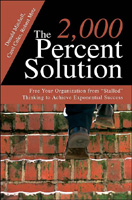 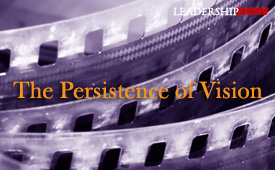
The Persistence of Vision MICHAEL MCKINNEY 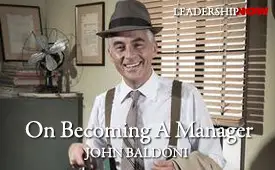
On Becoming A Manager JOHN BALDONI 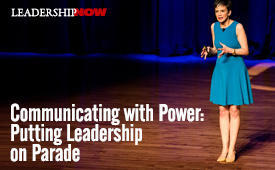
Communicating with Power: Putting Leadership on Parade KEVIN DALEY 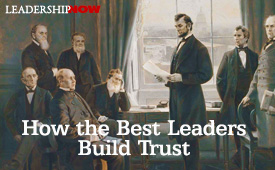
How the Best Leaders Build Trust STEPHEN M. R. COVEY 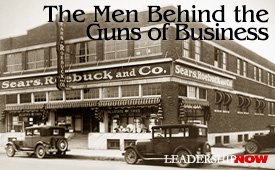
The Men Behind the Guns of Business RICHARD W. SEARS 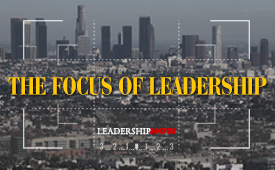
The Focus of Leadership MICHAEL MCKINNEY 
Why Leaders Fail MARK SANBORN |
 |
| ||
 | © 2019 LeadershipNow All materials contained in https://www.LeadershipNow.com are protected by copyright and trademark laws and may not be used for any purpose whatsoever other than private, non-commercial viewing purposes. Derivative works and other unauthorized copying or use of stills, video footage, text or graphics is expressly prohibited. |
||